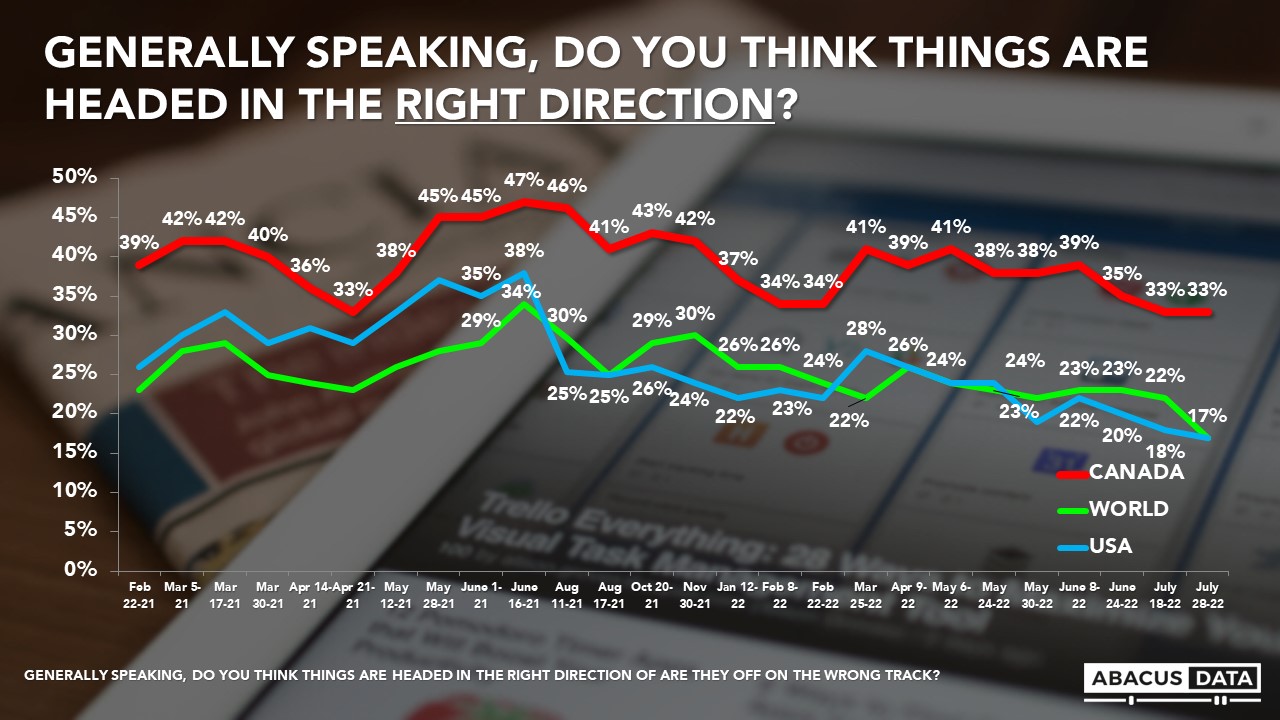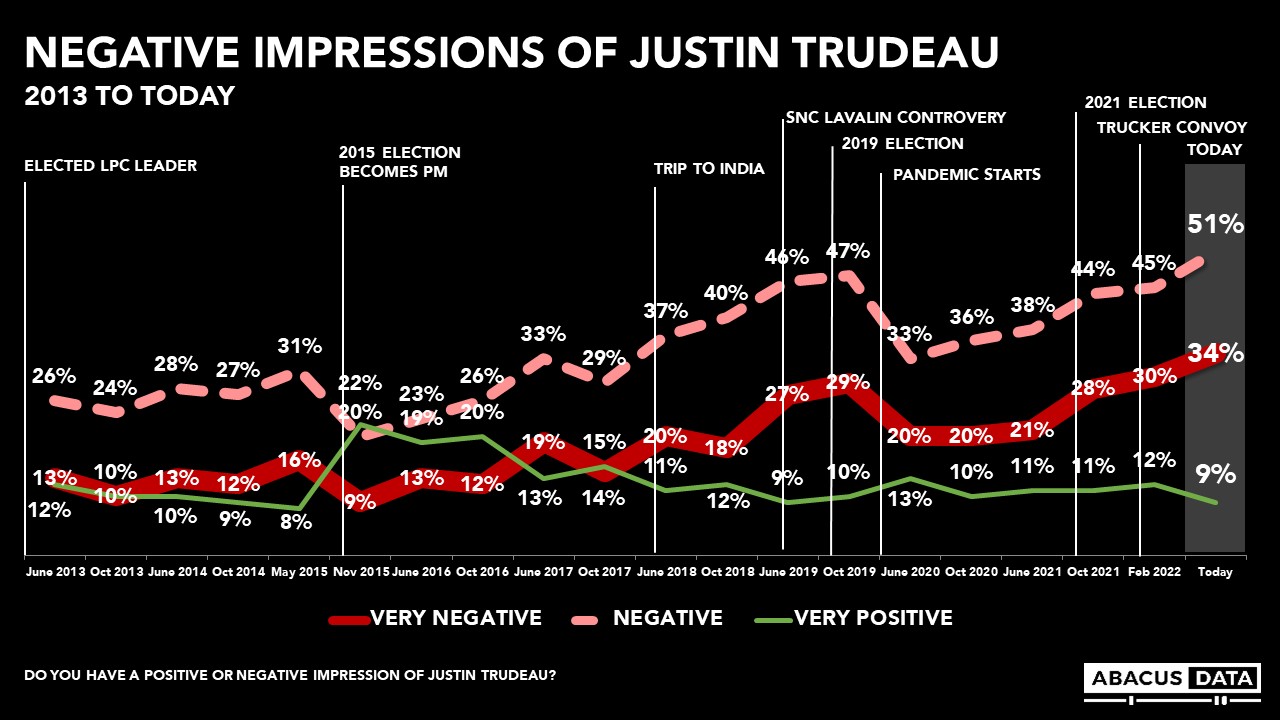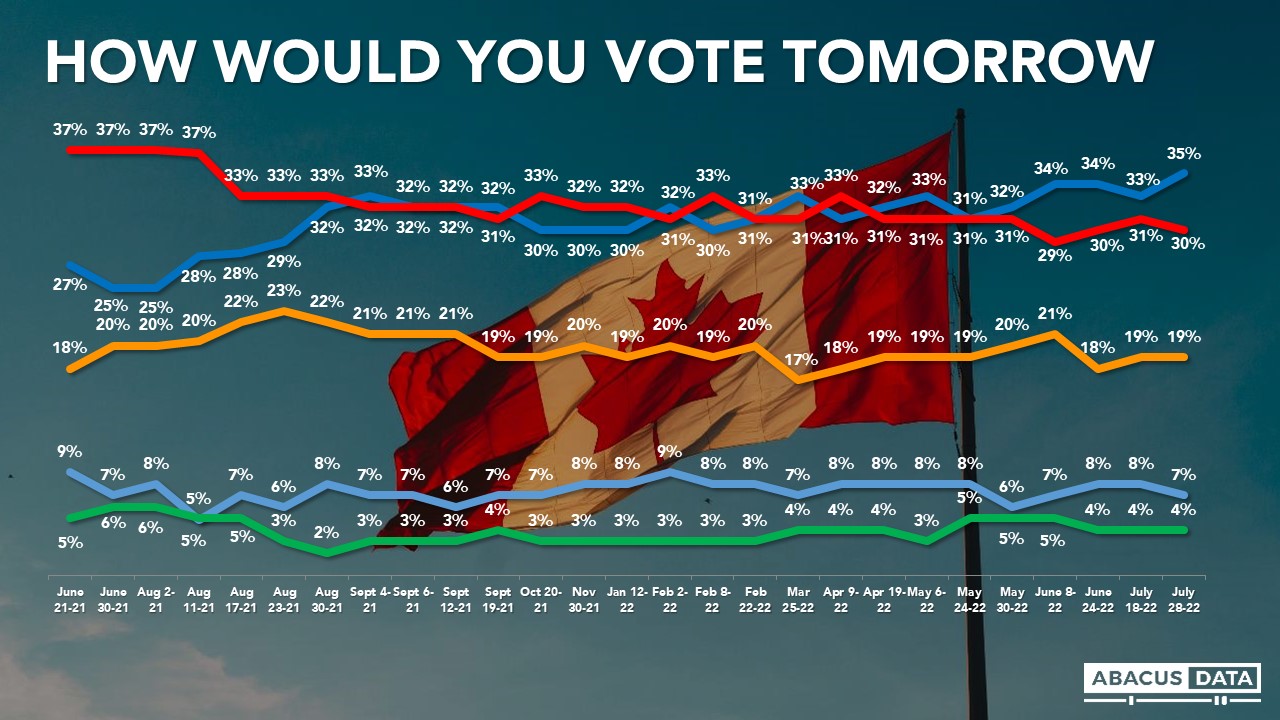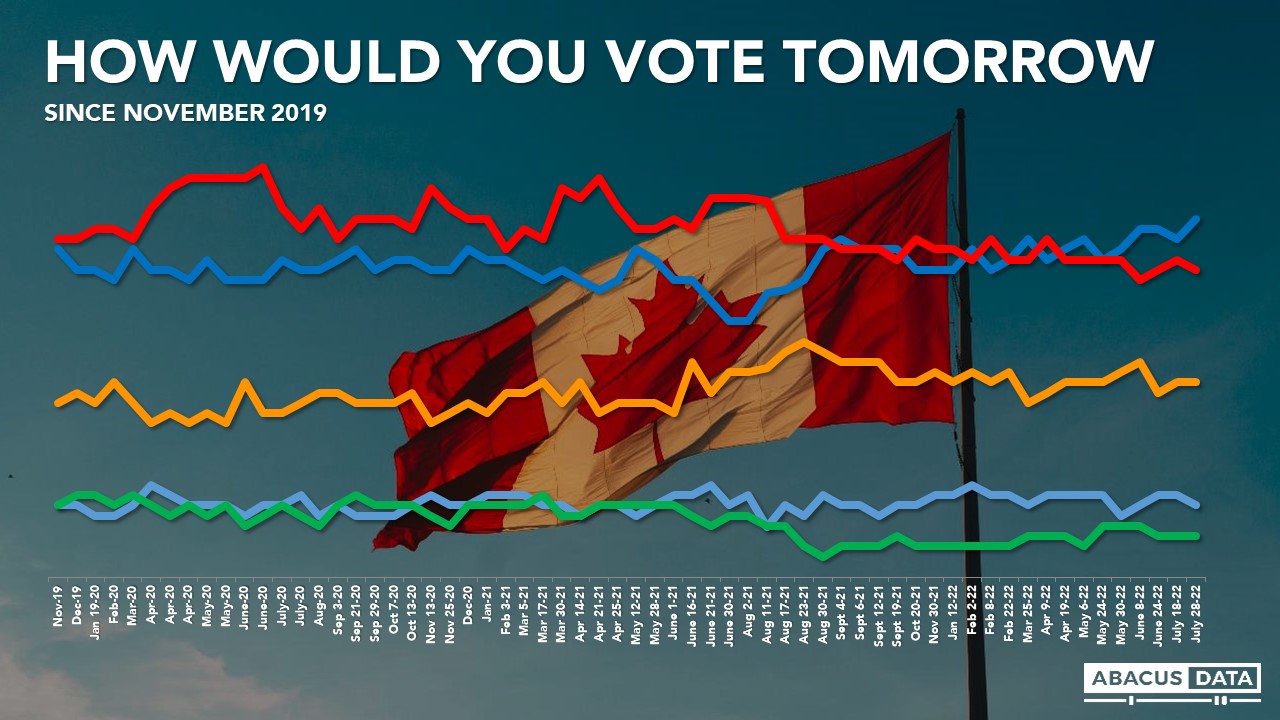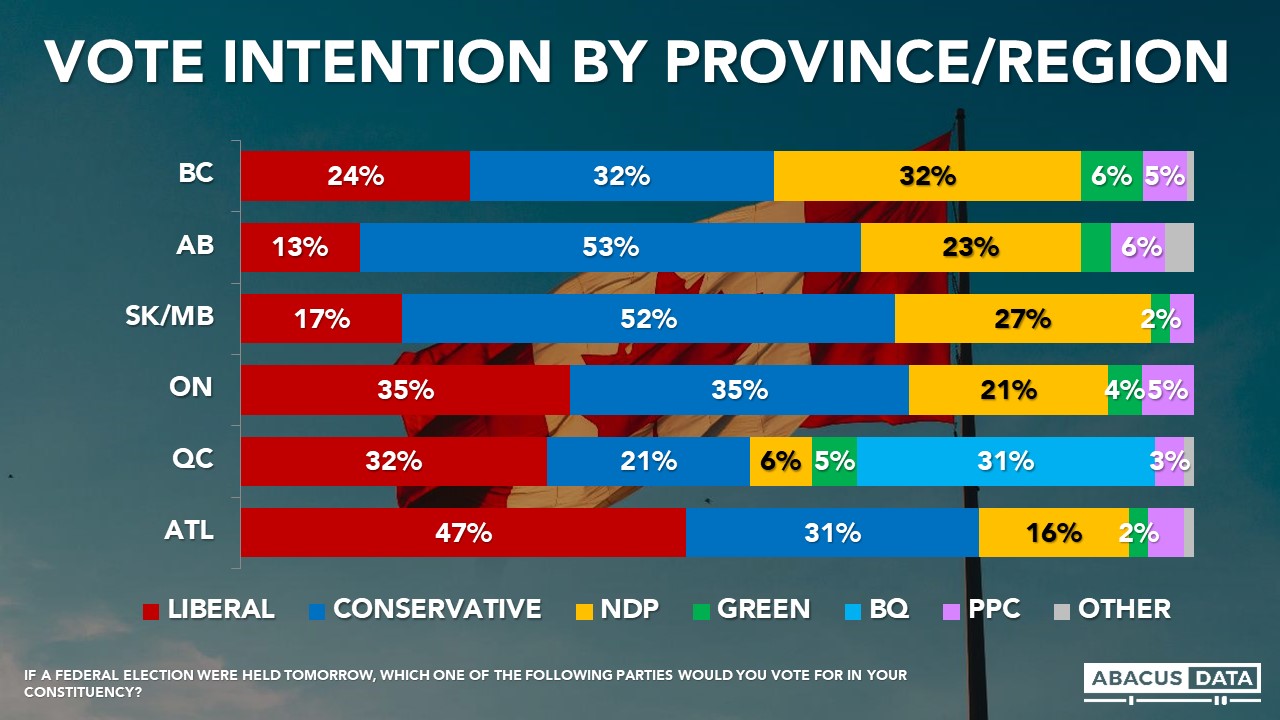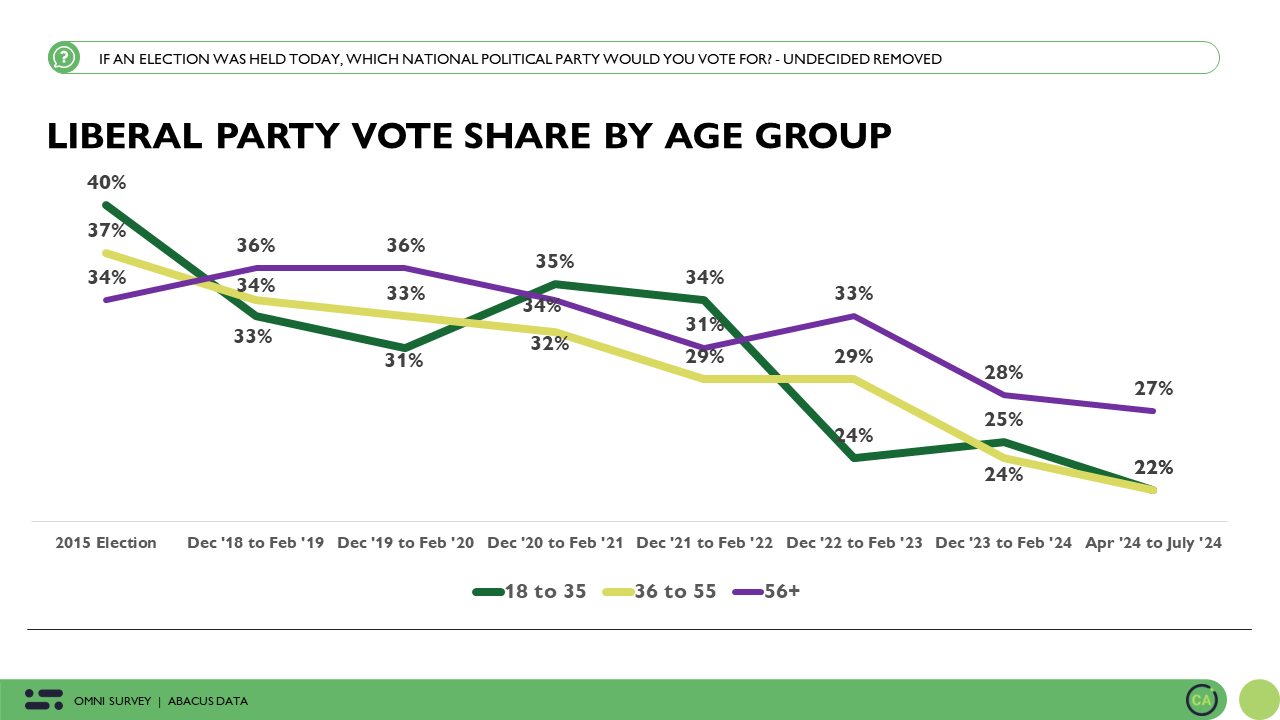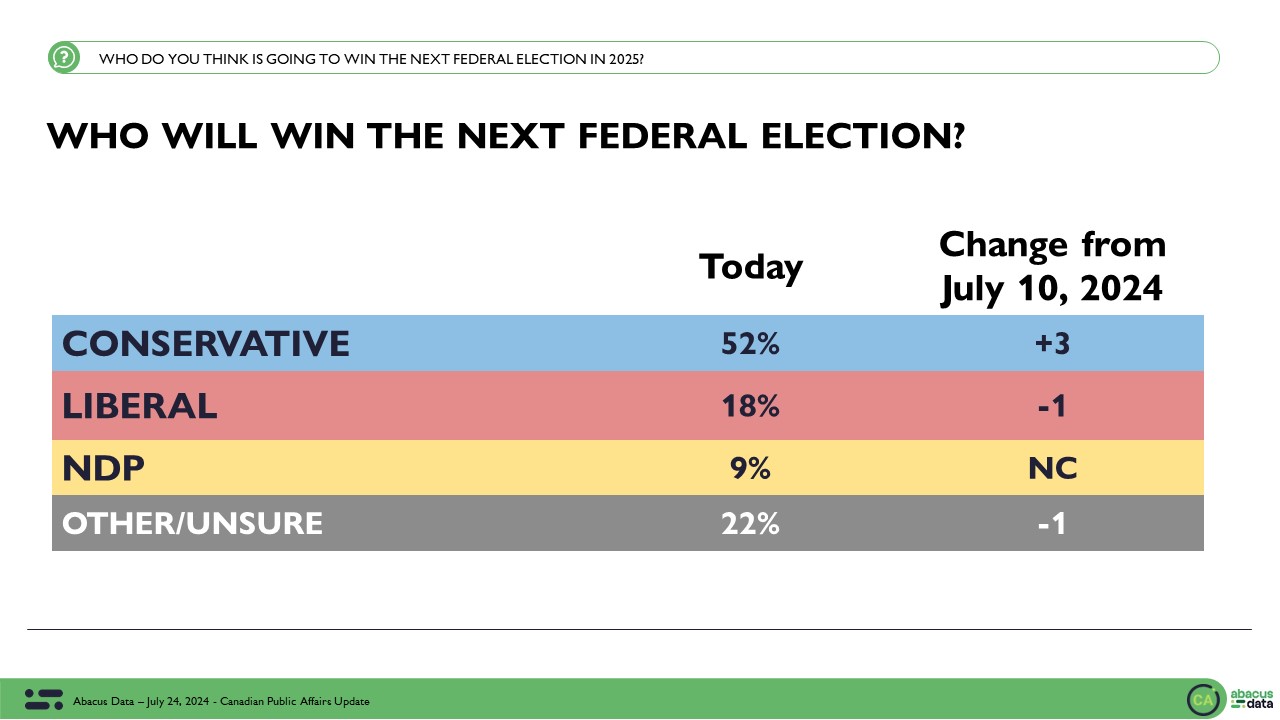Conservative lead widens as unhappiness with federal government and Prime Minister Trudeau grows
July 30, 2022
We just completed a national survey of 2,400 Canadian adults from July 22 to 27, 2022.
NATIONAL MOOD
Today 33% of Canadians think the country is headed in the right direction, which is 8-10 points below where things were a year ago. Views of the direction of the world and the United States have hit lows we haven’t seen since Donald Trump was US President.
DISAPPROVAL OF THE FEDERAL GOVERNMENT HITS NEW HIGH
Approval of the federal government is sagging. Today, 34% approve of the government’s performance, down 4-points this month, while disapproval has spiked to 51% (up 5 points in two weeks), the highest number ever recorded since the Trudeau government was elected in 2015 and the highest since March 2019 in the middle of the SNC Lavalin controversy.
IMPRESSIONS OF PM TRUDEAU
This survey finds 51% offering a negative view of Justin Trudeau, which is the highest number we have recorded since 2015. Today 31% have a positive impression of Mr. Trudeau, which is also the lowest number we’ve recorded.
His -20 net score compares to a -7 net score for Conservative leadership candidate Pierre Poilievre and the -5 for Jean Charest.
Among those who self-describe on the left of the spectrum, Trudeau is 47% positive and 35% negative. Among those in the centre, he is only 27% positive and 50% negative. He is 19% positive and 73% negative among those on the right. Trudeau’s negatives are 50% or higher in every income group.
Regionally, the Prime Minister’s net score is -17 in BC, -54 in Alberta, -46 in Saskatchewan and Manitoba, -16 in Ontario, -11 in Quebec, and -2 in Atlantic Canada.
Among those who voted Liberal in 2021, his net score is +64. Among Conservative voters, it is -80, -47 among BQ voters, and among NDP voters, it is -24.
Just to underscore how unhappy Conservative supporters are with Mr. Trudeau, 65% have a “very negative” view of Mr. Trudeau – almost double the national average of 34%.
CONSERVATIVE LEADERSHIP
We will do more in an upcoming release about the Conservatives and their leadership race, but it is worth noting that among those who voted Liberal in 2021, only 39% have a negative view of Pierre Poilievre, and 12% have a positive view – the plurality (49%) are neutral towards the presumed Conservative front runner.
Among those on the centre of the spectrum, Poilievre is 15% positive, 20% negative, meaning a lot of centrist votes are up for grabs – and his -5 net score with this group compares favourably to Trudeau’s -23.
VOTING INTENTION
If an election were held now, the Conservatives would win 35% compared to 30% for the Liberals and 19% for the NDP. Compared with our last survey, the Conservatives are up 3-points while the Liberals are down 2.
The People’s Party registers just 4% in this wave, which may suggest that the Conservatives are picking up support from the PPC as well as from the Liberals.
This is the first time since the 2015 election that we have measured Conservative vote share at 35% and the first time in which the Conservatives have led the Liberals consistently for several months.
• BC: Conservatives and the NDP are at 32%, and the Liberals at 24%.
• Alberta: 53% would vote Conservative compared with 23% for the NDP, 13% for the Liberal Party, and 6% for the People’s Party.
• Manitoba and Saskatchewan: The Conservatives lead with 52% followed by the NDP at 27%, the Liberals at 17%, and the People’s Party at 9%.
• Ontario: The Liberals and the Conservatives are tied at 35%, with the NDP at 21%. The People’s Party is polling at 5% in Ontario.
• Quebec: We see the BQ and Liberals basically tied (31% to 32%) with the Conservatives at 21%, and the NDP at 6%.
• Atlantic: The Liberals are well ahead of the Conservatives (47% to 31%), with the NDP in third at 16%.
Among those who self-identify in the centre of the political spectrum (49% of the electorate), the Conservatives lead by 4 over the Liberals (33% to 29%), while the Conservatives lead by 48 among those on the right and the Liberals lead by 12 (over the NDP) among those on the left.
Also, among those centrist voters, the Conservatives have a slightly larger pool of accessible voters, but all three main parties have similar sized pools: 48% would consider voting Conservative, 44% would consider voting Liberal, and 44% would consider voting NDP.
One final point, when we compare how people say they voted in September 2021 (the last federal election) and how they would vote today, the Conservative Party is holding onto 92% of its past vote while gaining a little from the Liberals, NDP, and a considerable portion of past PPC voters.
The NDP is holding 82% of its past vote while gaining 9% of past Liberal voters.
The Liberal Party is holding 81% of its past vote (losing 9% to the NDP, and 6% to the Conservatives) while gaining 7% from the NDP.
The BQ is holding 95% of its past support (losing 4% to the Conservatives).
UPSHOT
 According to Bruce Anderson: “These numbers are a clear signal to the Liberals that many voters, including large numbers of people on the centre of the spectrum, are restless. The Conservatives are highly competitive, views of Pierre Poilievre are more neutral than some might expect, and not very many people feel good about the direction of the country.”
According to Bruce Anderson: “These numbers are a clear signal to the Liberals that many voters, including large numbers of people on the centre of the spectrum, are restless. The Conservatives are highly competitive, views of Pierre Poilievre are more neutral than some might expect, and not very many people feel good about the direction of the country.”
 According to David Coletto: “These results should be a warning sign to the Liberals that they have entered unchartered territory for their government. For the first time in our tracking, 50% or more of people disapprove of the government’s job performance. The Prime Minister’s negatives have also hit a new high. It is a toxic cocktail when people are unhappy with the direction of the country and they disapprove of the government’s performance. That’s where we are today. The result is a wider Conservative Party lead and growing desire for change.”
According to David Coletto: “These results should be a warning sign to the Liberals that they have entered unchartered territory for their government. For the first time in our tracking, 50% or more of people disapprove of the government’s job performance. The Prime Minister’s negatives have also hit a new high. It is a toxic cocktail when people are unhappy with the direction of the country and they disapprove of the government’s performance. That’s where we are today. The result is a wider Conservative Party lead and growing desire for change.”
METHODOLOGY
The survey was conducted with 2,400 Canadian adults from July 22 to 27, 2022. A random sample of panelists were invited to complete the survey from a set of partner panels based on the Lucid exchange platform. These partners are typically double opt-in survey panels, blended to manage out potential skews in the data from a single source.
The margin of error for a comparable probability-based random sample of the same size is +/- 2.0% 19 times out of 20.
The data were weighted according to census data to ensure that the sample matched Canada’s population according to age, gender, educational attainment, and region. Totals may not add up to 100 due to rounding.
This survey was paid for by Abacus Data Inc.
Abacus Data follows the CRIC Public Opinion Research Standards and Disclosure Requirements that can be found here: https://canadianresearchinsightscouncil.ca/standards/
ABOUT ABACUS DATA
We are the only research and strategy firm that helps organizations respond to the disruptive risks and opportunities in a world where demographics and technology are changing more quickly than ever.
We are an innovative, fast-growing public opinion and marketing research consultancy. We use the latest technology, sound science, and deep experience to generate top-flight research-based advice to our clients. We offer global research capacity with a strong focus on customer service, attention to detail, and exceptional value.
We were one of the most accurate pollsters conducting research during the 2021 Canadian election following up on our outstanding record in 2019.
Contact us with any questions.
Find out more about how we can help your organization by downloading our corporate profile and service offering.

